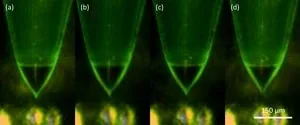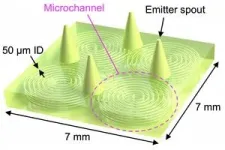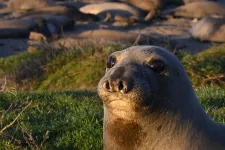(Press-News.org) The Ecological Society of America (ESA) announces the 2025 cohort of ESA Excellence in Ecology (EEE) Scholars. This prestigious scholarship program celebrates and supports outstanding early- to mid-career Ph.D. ecologists from groups traditionally underrepresented in the scientific community.
This year’s EEE Scholars are: Elvira D'Bastiani, Postdoctoral Researcher at the University of California, Los Angeles; Gabriela Garcia, Assistant Professor at Northeastern University; Camille Griffith, Assistant Professor at Oglala Lakota College; and Estelí Jiménez-Soto, Assistant Professor at the University of South Florida.
“These exceptional scholars embody the talent and dedication that drive ecology forward,” ESA Executive Director Catherine O’Riordan said of this year’s cohort. “Their work — spanning disease ecology, socio-ecological resilience, Indigenous knowledge and agroecology — expands the boundaries of this field while fostering inclusivity and community engagement. ESA is proud to support their contributions to science and society.”
Each scholar will receive an award of $5,000 over two years. This funding will support their participation in speaking opportunities at ESA annual meetings or events, as well as research endeavors, family/childcare support, hosting webinars and covering publication fees in one of ESA’s Open Access journals.
Meet the 2025 EEE Scholars
Elvira D'Bastiani – Postdoctoral Researcher, University of California, Los Angeles
D’Bastiani is a quantitative ecologist focused on understanding the ecological and evolutionary dynamics of infectious diseases. She earned her M.Sc. and Ph.D. in Ecology and Conservation from Universidade Federal do Paraná, Brazil. Her research integrates ecology, evolutionary history, network science, mathematical modeling, natural history and empirical data to deepen our understanding of host-parasite and host-pathogen relationships. Her current projects explore the ecology and evolution of pathogen movement from one species to another — so-called “spillover events”. Beyond her research, Elvira is dedicated to initiatives like the “Women in Ecology” project that foster a more inclusive science.
Gabriela Garcia – Assistant Professor, Northeastern University
Garcia leads the Socio-ecological Systems Dynamics Lab at Northeastern University. She received her Ph.D. from Tufts University and was a Fulbright-García Robles Postdoctoral Scholar at the Universidad Nacional Autónoma de México. Her research examines how humans interact with ecosystems, and how those relationships influence human well-being and the ways in which ecosystems function. With a focus on smallholder agriculture, much of her work jointly addresses the issues of biodiversity loss, food security and climate change. Her research group holds reciprocity and community engagement as core principles of their work. Garcia is an award-winning mentor and community-builder for scholars with underrepresented identities.
Camille Griffith – Assistant Professor, Oglala Lakota College
Griffith is a member of the Oglala Lakota Nation and a wildlife ecologist. She received her M.S. in Integrative Genomics from Black Hills State University and her Ph.D. in Wildlife Science from Purdue University. Her research integrates Lakota knowledge with Western science to address environmental and social challenges, focusing on Native American self-determination and empowering Native communities. At Oglala Lakota College, she manages the Natural History Collections, serves on research review boards and advocates for tribally owned, accessible data storage. She mentors students in ecological modeling for projects including Tinpsila (prairie turnip) conservation, reservation dog population monitoring and mapping culturally significant Reservation sites. Her research initiatives amplify Lakota voices in STEM through elevating community-driven, culturally relevant solutions to environmental challenges.
Estelí Jiménez-Soto – Assistant Professor, University of South Florida
Jiménez-Soto is a Mexican agroecologist with an M.A. and Ph.D. from the University of California Santa Cruz’s Environmental Studies program. Her research lies at the intersection of biodiversity conservation, agriculture and food sovereignty, and draws from a variety of disciplines and concepts including community ecology and political ecology. Much of her work takes place in Latin America, particularly in Chiapas, Mexico, where she studies insect communities and nature-human relationships in coffee plantations. She also works with community gardens in Tampa, Florida, to explore similar questions in urban settings. Through her work, she builds alliances among scholars, farmers, students and social movements to foster a more sustainable and just food system. Her goal is to be an inspiration for other women and minorities in ecology through her research, teaching and leadership roles at ESA.
###
The Ecological Society of America, founded in 1915, is the world’s largest community of professional ecologists and a trusted source of ecological knowledge, committed to advancing the understanding of life on Earth. The 8,000 member Society publishes six journals and a membership bulletin and broadly shares ecological information through policy, media outreach and education initiatives. The Society’s Annual Meeting attracts 4,000 attendees and features the most recent advances in ecological science. Visit the ESA website at https://www.esa.org
Follow ESA on social media:
X/Twitter – @esa_org
Bluesky – @ecologicalsociety.bsky.social
Instagram – @ecologicalsociety
Facebook – @esa.or
END
Rivers and streams may look permanent, but their lengths can change dramatically with the seasons, according to a new study. It reports that stream networks in the United States expand up to five times their low-flow size during wet conditions. The findings offer the first large-scale insights into how water dynamically moves through landscapes and provide a framework for forecasting climate-driven changes in stream networks, particularly in response to increasing storminess. Traditionally regarded as ...
Despite record rainfall in the region in early 2023, only a fraction of Southern California’s groundwater reserves has been replenished, researchers report. Their study, which leverages seismic noise data from across Greater Los Angeles, highlights the urgent need for improved monitoring and management of the state’s critical groundwater reserves. After enduring two decades of severe drought, California experienced an abrupt meteorological shift in water in 2023. A succession of 16 atmospheric rivers from late 2022 through early 2023, followed by the torrential ...
Northern elephant seals may hold the key to unlocking the secrets of the open ocean’s twilight zone (~200 – 1,000 meters deep). According to a new study, these deep-diving creatures can help estimate fish abundance by providing a rare window into the elusive prey dynamics in one of the planet’s most mysterious and remote ecosystems. Ecosystems are dynamic, with resource fluctuations – natural or human-induced – shaping species interactions and food webs. These processes are well studied in terrestrial ecosystems but not in deep, open ocean ecosystems, ...
Adults with a history of depression gain long-term physical conditions around 30% faster than those without, according to research publishing February 13th in the open-access journal PLOS Medicine. Kelly Fleetwood of the University of Edinburgh, United Kingdom, and colleagues argue that their study suggests depression should be viewed as a ‘whole body’ condition, and integrated approaches should be used to manage mental and physical health.
Depression is the most common mental health condition and ...
The greater Los Angeles area has long been subject of intense seismographic monitoring. A network of highly sensitive seismometers peppers the region on a constant vigil for earthquakes. Now researchers at the Stanford Doerr School of Sustainability have developed a new way to use that existing infrastructure and its decades of data to estimate water levels in the region’s aquifers, which serve some 10 million residents of Los Angeles and Orange counties.
The researchers analyzed the ...
EMBARGOED until Thursday, Feb.13, 2025, at 2 P.M. U.S. Eastern Time
SANTA CRUZ, Calif. – Over the past 60 years, marine biologists at UC Santa Cruz have monitored the behavior of northern elephant seals that journey to nearby Año Nuevo Natural Reserve. With the seals gathering on the beach by the thousands to breed and molt, generations of researchers have been able to amass more than 350,000 observations on over 50,000 seals.
With the help of powerful technologies and the intrepidness to get close ...
To find the cause of the "dessert stomach", the researchers investigated the reaction of mice to sugar and found that completely satiated mice still ate desserts. Investigations of the brain showed that a group of nerve cells, the so-called POMC neurones, are responsible for this. These neurones become active as soon as the mice were given access to sugar which facilitated their appetite.
When mice are full and eat sugar, these nerve cells not only release signaling molecues that stimulate satiety, but also one of the body's own opiate: ß-endorphin. This acts on other nerve cells with opiate receptors and triggers a feeling of reward, ...
A fungal infection has been shown to trigger a fruit fly’s own immune system to destroy brain cells leading to signs of neurodegeneration, a new study has found.
The paper published in PLOS Biology today found that a fungus called Beauveria bassiana was able to make the fly’s innate immune system trigger a process that kills neurons and glia in the brain, leading to more than half of flies dying after seven days compared to half of control samples living for nearly 50 days.
In experiments conducted by a team of academics from the University of ...
Leuven, 14 February 2025 – In a new study published in Science, a Belgian research team explores how genetic switches controlling gene activity define brain cell types across species. They trained deep learning models on human, mouse, and chicken brain data and found that while some cell types are highly conserved between birds and mammals after millions of years of evolution, others have evolved differently. The findings not only shed new light on brain evolution; they also provide powerful tools for studying how gene regulation shapes different cell types, across species or different disease states.
Our brain, and by extension ...
The pallium is the brain region where the neocortex forms in mammals, the part responsible for cognitive and complex functions that most distinguishes humans from other species. The pallium has traditionally been considered a comparable structure among mammals, birds, and reptiles, varying only in complexity levels. It was assumed that this region housed similar neuronal types, with equivalent circuits for sensory and cognitive processing. Previous studies had identified the presence of shared excitatory and inhibitory neurons, as well as general connectivity patterns suggesting a similar evolutionary path in these ...





